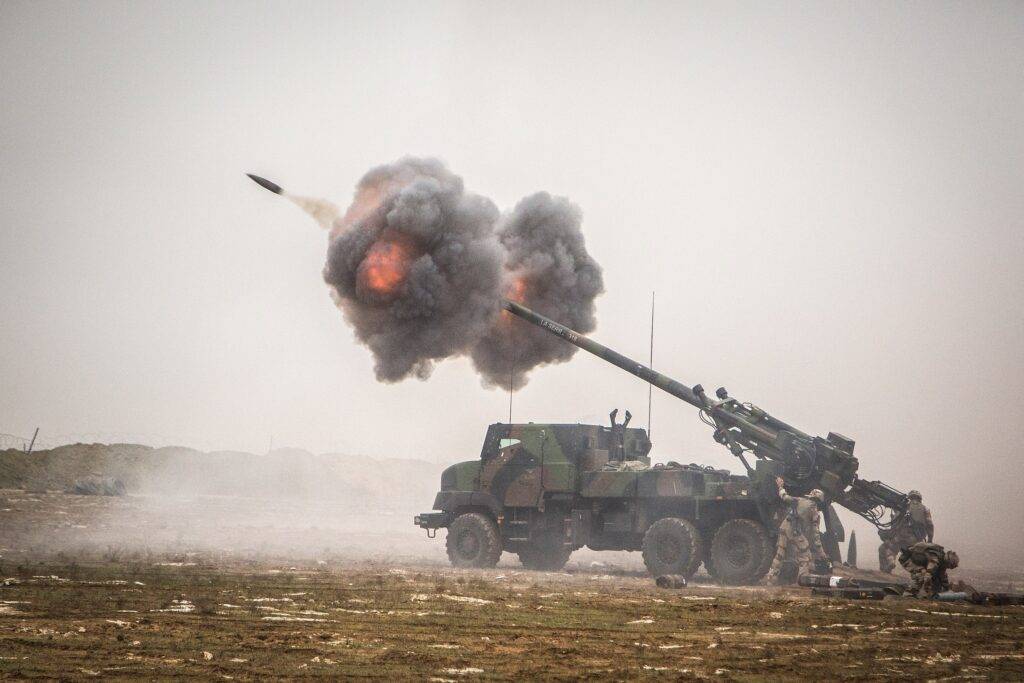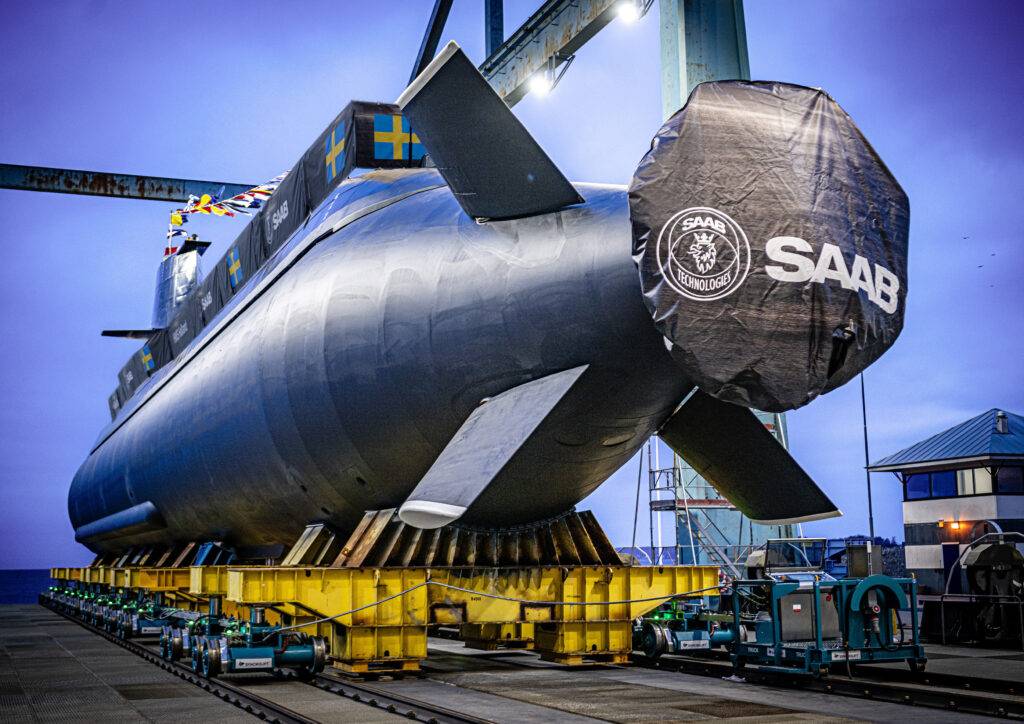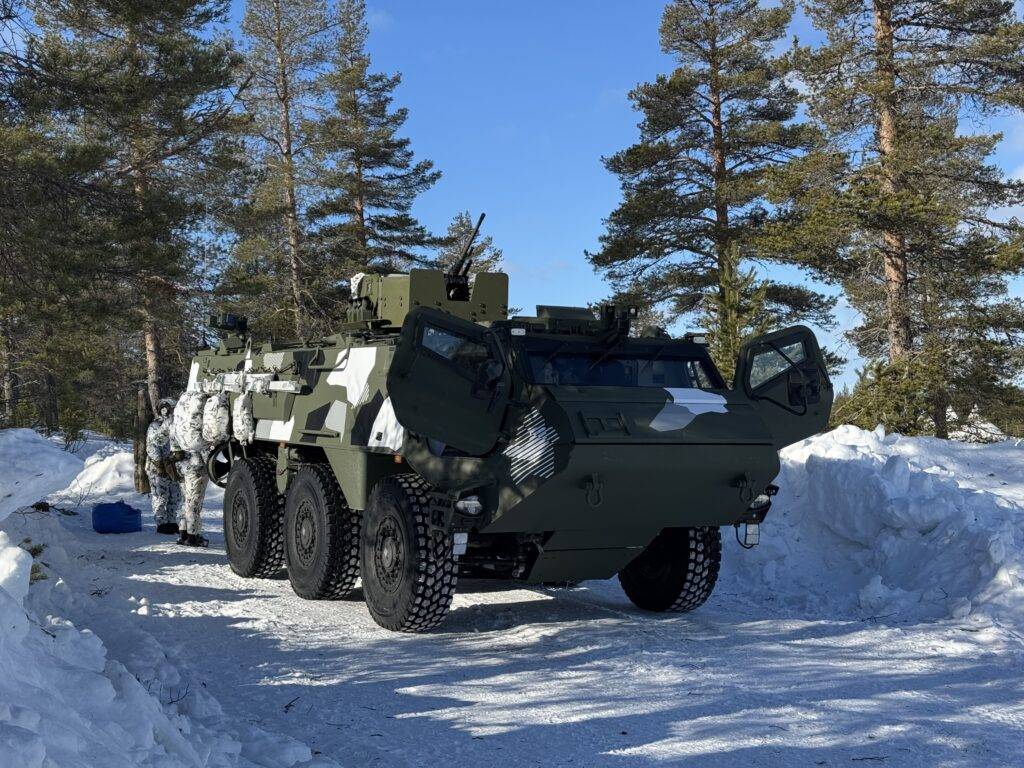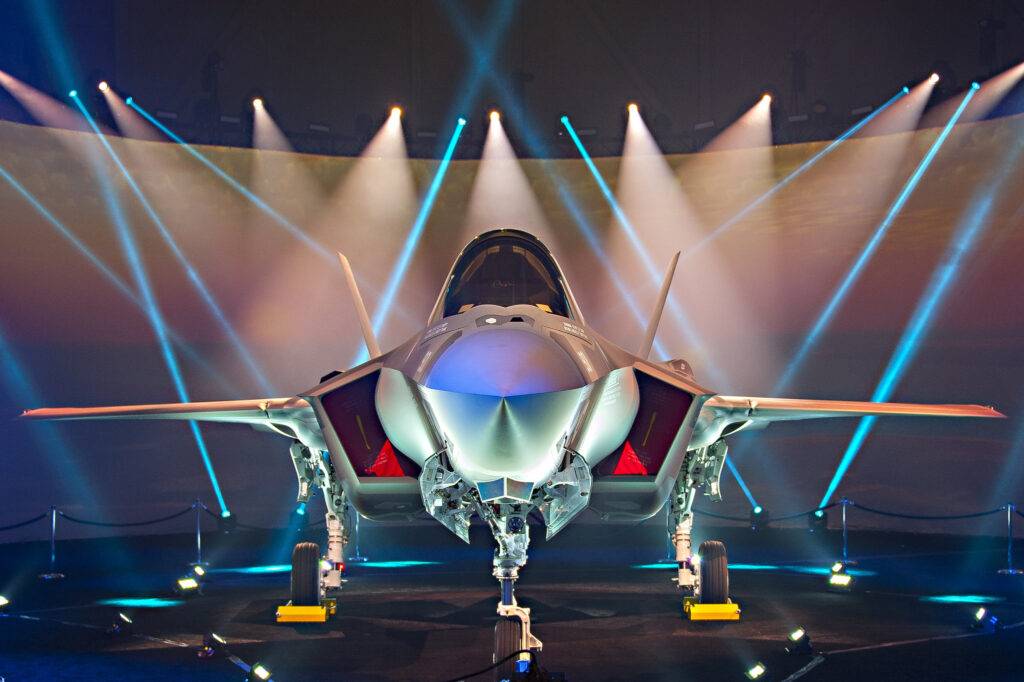The United States has dominated the global arms trade for decades. In the past five years, its exports have surged, reinforcing its position at the top. But the ground is shifting. What are the trends, who are the key players, and where does this leave the industry? Tariff disputes and uneasy allies – including Portugal and Canada reconsidering major deals – could leave a lasting impact on global defence markets. Which alternatives are most likely to replace American defence products?
U.S. arms exports reach a record USD 318.7 billion in 2024 – a 29 percent increase from the previous year. Among the biggest sales approved in 2024 were $23 billion worth of F-16 jets and upgrades to Turkey, $18.8 billion worth of F-15 fighter jets to Israel, and $2.5 billion worth of M1A2 Abrams tanks to Romania.
Between 2020 and 2024, U.S. arms exports rose by 21 percent, pushing America’s share of global arms exports from 34 to 43 percent. The surge reflects rising demand for U.S. military equipment, particularly across Europe and Asia. Over the same period, Russia’s global arms exports fell by 64 percent, while China’s declined by 5.4 percent.
According to SIPRI, U.S. manufacturers have secured future orders—set for delivery after 2024—for 996 combat aircraft, including trainer jets and anti-submarine warfare aircraft. France has secured 214 such orders, Russia 71, China 57, Italy 50, the UK 14, and South Korea 140. For combat helicopters, the U.S. holds 342 future orders.
In the category of tanks and fire-support vehicles, the U.S. has 403 orders, compared to Russia’s 454, China’s 500, Germany’s 416, Italy’s 96, Israel’s 19, and South Korea’s 916. For other armoured vehicles, the U.S. has more than 1,706 on order, France 537, Germany over 1,404, Italy 1,865, Israel over 124, Spain 517, and South Korea over 626.
When it comes to artillery, the U.S. has more than 678 confirmed deals. France follows with 251, China over 128, Germany over 72, Israel over 51, and South Korea with more than 1,203.
In terms of financial value, U.S. arms exports totalled around $11.29 billion in 2023, down from $15.59 billion in 2022. Despite the dip, the five-year trend shows continued strong growth.
Top Destinations for U.S. Arms Exports (2019–2023)
- Saudi Arabia: 15% of total U.S. arms exports
- Japan: 9.5%
- Australia: 7.1%
- South Korea: 5.3%
- Qatar: 8.2%
- Kuwait: 4.5%
- Israel: 3.6%
- United Kingdom: 3.2%
- India: 2.9%
- United Arab Emirates: 2.4%
European NATO countries have more than doubled their arms imports in recent years, with over 60 percent of those imports coming from the U.S.—a clear sign of the enduring transatlantic defence relationship.
According to SIPRI’s latest data for 2024, the top ten global arms importers are:
- Ukraine: 8.8% of global imports
- India: 8.3%
- Qatar: 6.8%
- Saudi Arabia: 6.8%
- Pakistan: 4.6%
- Japan: 3.9%
- Australia: 3.5%
- Egypt: 3.3%
- United States: 3.1%
- Kuwait: 2.9%
Top Ten U.S. Defence Exporters
- Lockheed Martin: Consistently the top U.S. defence contractor, with substantial revenue from defence contracts.
Defence revenue in 2023: $64.7 billion. - Boeing: BDS claims to be a global leader in the development, production, maintenance and enhancement of fixed-wing and rotary wing aircraft, commercial and government satellites, human spaceflight programs and weapons.
Defence revenue in 2023: $32.7 billion. - Northrop Grumman: A leading provider of full-spectrum cyber across land, air, sea and space. Land: Critical logistics, sustainment and modernization service. Sea: Designing, developing and producing naval systems. Space: National security launch systems and payloads to advanced communications satellites.
Defence revenue in 2023: $35.2 billion. - Raytheon Technologies: A developer and manufacturer of radars (including AESAs), electro-optical sensors, and other advanced electronics systems for airborne, naval, and ground-based military applications.
Defence revenue in 2023: $40.7 billion. - General Dynamics: Safety and security from Gulfstream business jets and combat vehicles to nuclear-powered submarines and communications systems.
Defence revenue in 2023: $33.6 billion. - BAE Systems Inc.: The U.S. subsidiary of the UK-based BAE Systems, generating significant revenue from U.S. defence contracts.
Defence revenue in 2023: $27.6 billion. - L3Harris Technologies: Communication systems, integrated mission systems, space and airborne systems. Formed from the merger of L3 Technologies and Harris Corporation in 2019.
Defence revenue in 2023: $15.5 billion. - Huntington Ingalls Industries: Specializes in shipbuilding, with steady revenue from naval contracts.
Defence revenue in 2023: $11.4 billion. - Leidos: Experienced growth through acquisitions, enhancing its defence portfolio: technology-enabled services and mission software capabilities for defence and intel customers in the areas of cyber, logistics, security operations, and decision analytics.
Defence revenue in 2023: $11 billion. - SAIC (Science Applications International Corporation): Focused on government services and information technology support.
Defence revenue in 2023: $3.8 billion.
Reconsideration of F-35 Deals
The Trump administration’s imposition of new tariffs, including a 10 percent levy on imports from various countries and to 20 percent levy from the EU, has raised concerns within the U.S. defence sector. These tariffs could disrupt global supply chains critical to weapons production, potentially increasing costs and delaying deliveries. Analysts warn that such policies might undermine international security partnerships and prompt allies to seek alternatives to U.S. defence products.
Both Portugal and Canada have expressed reservations about proceeding with their planned acquisitions of the U.S.-made F-35 fighter jets, citing geopolitical concerns and uncertainties regarding U.S. foreign policy. Portugal is exploring European alternatives, while Canada is assessing other options, including domestic assembly of fighter jets. Though lacking the F-35’s stealth capabilities, alternatives like the Saab Gripen, Eurofighter Typhoon, and Dassault Rafale are now being considered.
Emerging France, China, and Britain

Allied nations, concerned about the reliability of U.S. defence commitments, are increasingly turning to alternative suppliers to diversify their military acquisitions.
France has solidified its position as the world’s second-largest arms exporter, accounting for 9.6 percent of global arms exports, surpassing Russia but still trailing the United States. In 2024, French defence export contracts reached €18 billion, driven by sales of Rafale fighter jets and submarines. This surge reflects a growing international confidence in French defence products, positioning France as a viable alternative to U.S. suppliers.
China has supplied military equipment to approximately 40 countries over the past two decades. Between 2020 and 2024, China accounted for 5.9 percent of global arms exports, making it the fourth-largest arms exporter. Notably, Pakistan has been a major recipient, with 81 percent of its arms imports sourced from China during this period. China’s expanding defence industry and competitive pricing make it an attractive option for countries seeking alternatives to U.S. weaponry.
The UK maintains a robust defence industry, with plans to publish a comprehensive defence industrial strategy aimed at strengthening national security and boosting economic growth. British defence firms, such as BAE Systems, are well-positioned to capitalize on shifts in global defence procurement, offering advanced military technologies to nations diversifying away from U.S. suppliers.
Iron Beams and Submarines

Rafael Advanced Defense Systems, an Israeli defence technology company, specializes in developing and manufacturing a wide range of high-tech defence systems for air, land, sea, and space applications. Established over 75 years ago, Rafael invests approximately 7 percent of its sales in research and development, contributing to innovations like the Iron Beam laser air defence system. Israel’s defence industry, with companies like Rafael, offers cutting-edge solutions that appeal to countries seeking advanced military capabilities.
Defence companies in South Korea and Japan are experiencing increased interest from European nations aiming to bolster their military capabilities amid uncertainties in U.S. foreign policy. For instance, South Korea’s Hanwha Aerospace and Hyundai Rotem, as well as Japan’s Mitsubishi Heavy Industries, have seen their stock prices rise significantly. These companies are poised to secure contracts with European countries seeking reliable defence equipment suppliers.
Top Ten Alternatives to American Defence Products
- Dassault Rafale (France): A versatile multirole fighter jet known for its advanced avionics and combat capabilities. The Rafale has secured significant export deals, including a €18 billion contract in 2024.
- Nexter CAESAR (France): A 155mm self-propelled howitzer mounted on a truck chassis, offering mobility and precision. It has been exported to several countries, enhancing France’s defense export portfolio.
- Chengdu JF-17 Thunder (China): A lightweight, single-engine multirole combat aircraft developed jointly with Pakistan. It has been exported to countries like Nigeria and Myanmar, reflecting its growing international presence.
- Wing Loong UAV (China): An unmanned aerial vehicle used for surveillance and strike missions. Its affordability and capabilities have attracted buyers in the Middle East and Africa.
- BAE Systems Typhoon (United Kingdom): A highly agile multirole fighter aircraft developed through a European consortium. The Typhoon has been exported to nations such as Qatar, bolstering the UK’s defence exports.
- BAE Systems Hawk (United Kingdom): A single-engine, jet-powered advanced trainer aircraft. The Hawk is used by various air forces worldwide for pilot training.
- Rafael Iron Dome (Israel): A mobile all-weather air defence system designed to intercept and destroy short-range rockets and artillery shells. It has been widely adopted and praised for its effectiveness.
- Rafael Spike Missile (Israel): A fire-and-forget anti-tank guided missile with various variants for different platforms. It has been exported to numerous countries, enhancing their ground combat capabilities.
- Hanwha K9 Thunder (South Korea): A 155mm self-propelled howitzer known for its mobility and firepower. It has been exported to countries like Poland, contributing to South Korea’s defence industry growth.
- ShinMaywa US-2 (Japan): A large amphibious aircraft used for search and rescue missions. Japan has initiated exports of the US-2, marking its entry into the international defence market.
Top Ten Nordic Defence Products

- Saab JAS 39 Gripen (Sweden): A versatile multirole fighter aircraft known for its agility and cost-effectiveness. The Saab JAS 39 Gripen has secured confirmed deals with several nations, including Sweden, the Czech Republic, Hungary, South Africa, Thailand, and Brazil. Additionally, Colombia has recently announced its selection of the Gripen, with plans to acquire between 16 and 24 aircraft. The value of Brazil’s 2014 purchase of 36 Gripen jets is estimated to be worth $5.4 billion.
- Kongsberg Naval Strike Missile (Norway): A long-range, precision-guided missile designed for use against sea and land targets. It has been selected by navies in countries such as Poland and Malaysia.
- Saab GlobalEye (Sweden): An advanced airborne early warning and control (AEW&C) system that combines radar, surveillance, and command capabilities. Saab is advocating for Nordic countries to adopt the GlobalEye for collective patrols.
- Kongsberg Protector Remote Weapon Station (Norway): A remotely controlled weapon station that can be mounted on various vehicles and platforms, enhancing crew protection and operational capabilities. It has been widely adopted by several nations.
- Nammo Ammunition Products (Norway/Finland): Nammo specializes in the production of ammunition, including small and medium calibre rounds, large calibre systems, and shoulder-fired systems like the M72 LAW. Their products are used by armed forces worldwide.
- Saab Kockums Submarines (Sweden): Saab Kockums designs and manufactures submarines, such as the Gotland-class and the upcoming Blekinge-class (A26), known for their stealth and advanced capabilities.
- Kongsberg Joint Strike Missile (Norway): A long-range precision strike missile designed for use with the F-35 Lightning II and other aircraft, offering advanced capabilities against sea and land targets.
- Saab Carl-Gustaf M4 (Sweden): A man-portable, multi-role weapon system used for a wide range of missions, including anti-armour and anti-structure operations. The latest M4 version offers improved ergonomics and compatibility with future battlefield technologies.
- Patria AMV (Finland): Both 8×8 and it multinational CAVS program 6×6 multi-role military vehicles known for their modularity, protection, and mobility. They have been exported and sold to several countries, including Poland, Croatia, South Africa and most recently Denmark.
- Kongsberg NASAMS (Norway): The National Advanced Surface-to-Air Missile System is a distributed and networked medium-range air defence system. It has been adopted by countries such as the United States, Finland, and Spain.
Read More:
- Defence Industry Europe: U.S. arms exports reach record USD 318.7 billion in fiscal year 2024
- Reuters: US arms exports hit record in 2024 on Ukraine-related demand
- WSJ: U.S. Dominates Arms Trade but Trump’s Moves Risk Rattling Buyers
- SIPRI: Trends in International Arms Transfers, 2024
- SIPRI: Trends in International Arms Transfers, 2023
- Statista: U.S. arms exports from 2000 to 2023
- The Guardian: After America: can Europe learn to go it alone without the US?
- Geopolitical Economy: USA is #1 arms dealer, exporting 43% of world’s weapons: 7 times more than China, 5x Russia
- SAN: US increased its global weapons exports, but will its dominance continue?
- Deloitte: US Aerospace and Defense Export Competitiveness Study
- Stanford: The U.S. Defense Industry and Arms Sales
- US Global Investors: The Top 10 U.S. Aerospace and Defense Contractors
- Defense News: Top 100 for 2024
- Politico: Trump’s tariffs threaten US weapons production
- The New Yorker: The Truth About Donald Trump’s “Liberation Day”
- The Independent: Three reasons Canada and Portugal may cancel order for US-made fighter jets
- Le Monde: France consolidates its position as the world’s second-largest arms exporter
- Defense Express: China Has Sold Weapons to 40 Countries in 20 Years, Pushing Out russia and the U.S.—Will Washington Respond?
- Defense News: Rafale jets, submarines push France’s defense exports to $19B in 2024
- The Diplomat: China’s Arms Imports Are Declining – But So Are Its Arms Exports
- IAF: Rafael Advanced Defense Systems Ltd
- Wikipedia: Iron Beam
- Reuters: UK plans defence industrial strategy next year, seeking growth boost
- Wikipedia: CAC/PAC JF-17 Thunder
- FT: Asian defence stocks soar to record highs as Europe prepares to re-arm
- Wikipedia: BAE Systems Hawk
- NY Post: Iron Dome for America: Hegseth teases Israeli-style air defense system order
- FT: Qatar looks to buy another 12 Typhoon jets from UK
- Wikipedia: Spike (missile)
- Asian Military Review: Chinese Political Ambition Restrains Defence Exports
- Wikipedia: K9 Thunder
- Wikipedia: Defense industry of Japan
- The Japan Times: Massive arms deals highlight South Korea’s growing defense industry
- Medium: Tokyo’s First Major Military Export Will Be a Seaplane
- FP: How Trump Is Killing the U.S. Defense Industry
- Bloomberg: Sweden’s Exports of Military Equipment Jump to Record High
- Prif: Europe’s Defence Dilemma: Rising Militarization Amidst Industrial Fragmentation and Weak Export Controls
- Reuters: Speed up defence output by ‘militarizing civilian ships’, Kongsberg suggests
- Wikipedia: Kongsberg Gruppen
- Wikipedia: Saab Kockums
- Wikipedia: Nammo
- Wikipedia: Saab JAS 39 Gripen
- FT: Saab urges Nordic neighbours to use spy plane touting its ‘unique capability’
- The Aviationist: Colombia Choses Saab JAS 39 Gripen as its Newest Frontline Fighter Jet
- CZDefence: The Gripen E is comparable to the F-35A in many ways
- 1945: JAS 39 Gripen Is No F-35 Fighter Replacement for Canada



